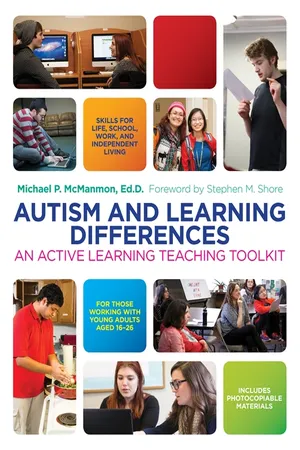![]()
Getting Started: Understanding the Clinical Diagnosis
UNDERSTANDING THE ASD DIAGNOSIS FROM A CLINICAL STANDPOINT
UNDERSTANDING A LEARNING DIFFERENCES (LD) DIAGNOSIS FROM A CLINICAL STANDPOINT
LOOKING AT AN ASPERGER’S DISORDER (AD) DIAGNOSIS FROM A CLINICAL PERSPECTIVE
UNDERSTANDING THE ASD/LD DIAGNOSIS FROM A TEACHING STANDPOINT
UNDERSTANDING THE ASD/LD DIAGNOSIS FROM A PARENTING STANDPOINT
UNDERSTANDING THE ASD/LD DIAGNOSIS FROM A STUDENT STANDPOINT
Understanding the Clinical Diagnosis
“A diagnosis is not a death sentence.”
Michael P. McManmon
“When one door closes, another opens; but we often look so long and so regretfully upon the closed door that we do not see the one that has opened for us.”
Alexander Graham Bell
“Show me imperfection and I’ll show you love: setting the brilliant course for caring and acceptance.”
Michael P. McManmon
“We are all different. Therefore, you could say everyone is to some degree . . . on the Spectrum; it is just a matter of how you learn to navigate your differences throughout your life.”
Holly Brouker, CIP Berkshire Center
“Each individual is unique and will not present the same. Individuals also come with different areas of strength and areas where they need assistance.”
Ginamarie Iannone, CIP Amherst
“The ASD and LD adolescents and young adults I work with are like my tulip garden: some bloom early, some bloom mid-season, and some bloom quite late. And I can tell you – without a doubt – that the late ones are just as beautiful.”
Michael P. McManmon
“ASD varies greatly from person to person (no two people with Autism are alike).”
National Autism Association, USA
“The most prevalent LD (Learning Difference) is in the area of reading, known as Dyslexia.”
NCLD – The National Center for Learning Disabilities, USA
“Total 2012 NHS budget: $30.86 billion: of this only $169 million goes directly to Autism research. This represents 0.55% of total NIH funding.”
The National Health Service, USA
“Currently 2.4 million students are diagnosed with ASD and LD representing 41% of all students in special education. Close to one-half of secondary students with an ASD or LD diagnosis perform below their enrolled grade, 45% in reading and 44% in math.”
NCLD – The National Center for Learning Disabilities, USA
“Autism now affects 1 in 68 children. Boys are four times more likely to have autism than girls. About 40% of children with an ASD diagnosis do not speak. About 25% to 30% of children have some words at 12 to 18 months of age and then lose them. Others might speak later in childhood. No two people with Autism are alike.”
Center for Disease Prevention, Atlanta, Georgia, USA
The number of students on the ASD/LD Spectrum grows daily. As high schools, colleges, and universities try to cope with the growing number of adolescents and young adults diagnosed with Autism Spectrum Disorder (ASD) and Learning Differences (LD), integrating, merging, and/or adapting a well-rounded, research-based pedagogy that gives students unparalleled support and guidance into existing curricula is essential.
The focus of Chapter 1: Getting Started is on understanding the criteria used to make an ASD (DSM–5 Autism Spectrum Disorder) or LD (Learning Difference) diagnosis from a clinical perspective and how this diagnosis impacts teachers, parents, and most importantly, the adolescents and young adults who carry the diagnosis. Emphasis on the criteria for Sensory Processing Disorders and Asperger’s Disorder (AD) is also included, as the rise in adolescents and young adults on the ASD/LD Spectrum with these classifications is much more prevalent today than in previous years and decades.
Chapter 1 takes the criteria used to determine individual learning styles and discusses the best ways to impart knowledge to the ASD or LD population via brain-theory-based teaching strategies. Looking at the diagnosis of ASD or LD from a clinical and teaching standpoint, as well as a student and parent perspective – as related to the day-to-day school experience of adolescents and young adult students in the classroom setting – gives the reader a solid, easy-to-understand starting point for comprehending and using the chapters that follow in a logical and organized way.
In order to utilize the information in the ensuing chapters effectively, reading this first chapter is necessary. It is the blueprint that allows the rest of the book to be constructed. Chapter 1 gives those who plan to use Autism and Learning Differences (An Active Learning Teaching Toolkit) a frame of reference for measuring success, as well as the strategies and teaching techniques for imparting the knowledge that will lead ASD and LD students to proficiency in the four competency areas: skills for life, school, work, and independent living. Understanding the wide range of criteria for an ASD or LD diagnosis (and the commonalities that both carry) from various viewpoints will allow practitioners to understand that skills for life, school, work, and independent living are vital and will allow these young men and women to become successful, valued, contributing, independent, and productive members of society.
So let’s get started!
Understanding the ASD Diagnosis from a Clinical Standpoint
We are witnessing a transformation in the way that adolescents and young adults diagnosed with Autism Spectrum Disorder (ASD) are educated. The experts tell us that the years between 18 and 26 can be extremely challenging for these young men and women. The struggle for independence is a difficult, arduous, and long process and emotions run very high. Instead of transitioning from dependence to independence, these adolescents and young adults withdraw and isolate. Feelings of anxiety, depression, and inadequacy, that have always been there, intensify. Their social skills are poor and structure (consistency, routines, rules, and predictability) is lacking. Rigid thinking and inflexibility are present, and most likely, healthy routines are not. Obsessions, fixations, and “special interests” take up an extraordinary amount of the adolescent’s or young adult’s time, leading to further isolation and reliance on these practices.
The 2013 DSM–5 (an internationally used medical manual) currently bases its description of those diagnosed with ASD (Autism Spectrum Disorder) on two sets of criteri...



